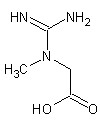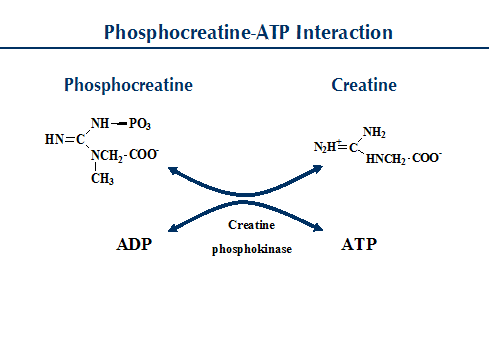What is creatine?
Creatine is an amino acid derivative constructed from arginine, glycine and methionine. It is produced naturally by the body in the kidneys, liver, and pancreas at a rate of about 1-2 grams/day. Creatine can also be obtained from food (particularly red meat) and supplementation.
The uptake of creatine into muscle cells is an active process. 90-95% of creatine in the body is found in muscle. This is why it is critical in assisting with muscular work and endurance.
Creatine is degraded into creatinine and excreted in the urine at a rate of around 2 grams/day. This means your body can get rid of it easily.
Why is creatine so important?
 The energy needs of brief, rapid and powerful movements lasting fewer than 10 seconds, such as a short sprint, are met by the phosphagen system. This system quickly replenishes the stores of adenosine triphosphate, or ATP, which provides energy to the working cells. Muscles have an existing amount of ATP hanging around ready for action, but only a little bit — enough for a few seconds. ATP is broken down by removing a phosphate, which turns it into adenosine diphosphate (two phosphates).
The energy needs of brief, rapid and powerful movements lasting fewer than 10 seconds, such as a short sprint, are met by the phosphagen system. This system quickly replenishes the stores of adenosine triphosphate, or ATP, which provides energy to the working cells. Muscles have an existing amount of ATP hanging around ready for action, but only a little bit — enough for a few seconds. ATP is broken down by removing a phosphate, which turns it into adenosine diphosphate (two phosphates).
To make more ATP, the muscles need to get the missing third phosphate from somewhere, quickly.
This is where creatine phosphate comes in. It takes one for the team by donating its phosphate so that ADP can become ATP again, and so you can finish that sprint.
Because creatine plays a major role in this system, more creatine means more potential ATP, which translates into improved performance on short-duration, high-intensity tasks. Because long-duration, low-intensity activities rely more on a different energy system, they are not typically enhanced by creatine — in other words, creatine will help a sprint but not a marathon.
Consuming creatine supplements can increase skeletal muscle free creatine (which makes up about 1/3) and phosphocreatine (which makes up about 2/3) concentrations. These are the naturally occurring energy pools that replenish ATP.
Uptake of creatine into muscle also has a cell volumizing effect by drawing water into the cell. Over the long term, this swelling may increase protein synthesis and glycogen storage.
What you should know
Creatine is taken as a supplement in the form of creatine monohydrate (mainly), because the phosphorylated creatine (creatine phosphate or phosphocreatine) does not pass through cell membranes.
Other forms of creatine supplements have not been heavily studied and may result in more of a by-product known as creatinine. A recent study found that “when compared to creatine monohydrate, creatine ethyl ester was not as effective at increasing serum and muscle creatine levels or in improving body composition, muscle mass, strength, and power.”
Creatine use can improve performance in high-intensity events (e.g., weight training, sprints, etc). Longer duration aerobic workouts may not benefit from regular creatine use.
When following high-dose creatine loading strategies, body mass can be increased by nearly 2 kg (over 4 lbs) in just 7 days. This is mainly due to increases in total body water. However, these rapid water gains are not necessarily associated with lower dose creatine use.
As previously mentioned, long-term use of creatine can stimulate muscle protein synthesis. Plus, when power and strength levels are enhanced, general muscular adaptation can occur indirectly.
The benefits of creatine supplementation may go beyond athletic performance: creatine may have neuro-protective effects on neurological diseases such as Huntington’s disease, Parkinson’s disease, amyotrophic lateral sclerosis (ALS, aka Lou Gehrig’s disease). More human trials are needed to confirm this.
For extra credit
Creatine appears to be safe to use while exercising in the heat.Creatine does not appear to increase the risk of cramping or injury. Combining caffeine with creatine shouldn’t negate its effects. (See Creatine Combinations)
Creatine supplementation may be even more beneficial in those on a plant-based diet, due to the lack of creatine consumption from food. About 20 percent of creatine users are deemed “non-responders.” This may occur because they already have a high enough dietary intake of creatine from whole foods. Conversely, creatine supplementation may be even more beneficial for those on a plant-based diet, due to the lack of creatine consumption from food.
A standard omnivorous diet contains about 1 gram of creatine per day. Typically, additionally benefits occur with intakes of 3-5 grams per day. Creatine supplementation may be more effective when combined with carbohydrates during the first few days of supplementation. This suggests that insulin may moderate its effects. However, after the first few days, carbohydrates may not be required.
Based on current data, long-term creatine supplementation does not result in adverse health effects.
Creatine supplementation may increase anterior compartment pressure in the lower leg so athletes may want to be careful with creatine supplementation if they’re prone to shin problems.
Summary and recommendations
If you decide to use a creatine supplement:
- Use the monohydrate form
- Consume 3-5 grams of creatine per day
- Dissolve the creatine in a warm beverage like green tea
- You can also take your creatine before and/or after workout sessions with your workout nutrition
- Take a break from creatine supplementation after using for 12-16 weeks







No comments:
Post a Comment